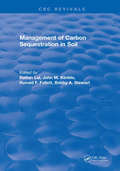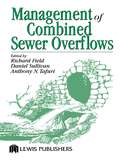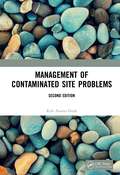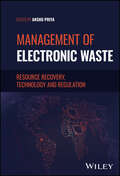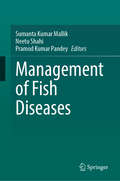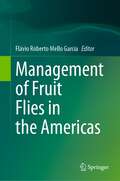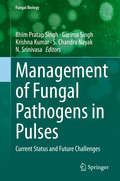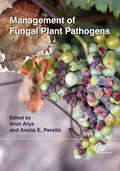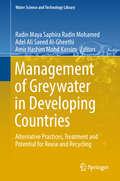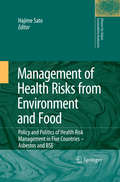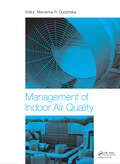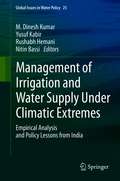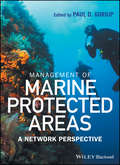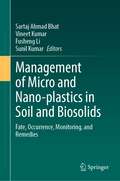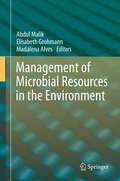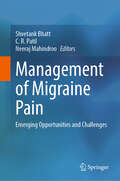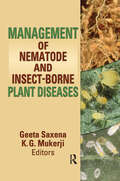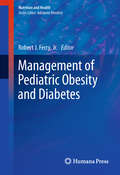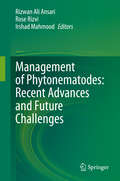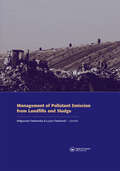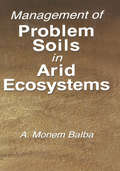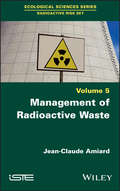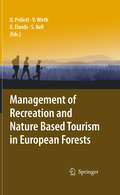- Table View
- List View
Management of Carbon Sequestration in Soil (Advances In Soil Science Ser. #10)
by Rattan LalThis book addresses the importance of soil processes in the global carbon cycle.Agricultural activities considered responsible for an increase in CO2 levels in our atmosphere include: deforestation, biomass burning, tillage and intensive cultivation, and drainage of wetlands.However, agriculture can also be a solution to the problem in which carbon can be removed from the atmosphere and permanently sequestered into the soil. Management of Carbon Sequestration in Soil highlights the importance of world soils as a sink for atmospheric carbon and discusses the impact of tillage, conservation reserve programs (CRP), management of grasslands and woodlands, and other soil and crop management and land use practices that lead to carbon sequestration.
Management of Combined Sewer Overflows
by Richard Field Daniel Sullivan Anthony N. TafuriThere are approximately 10,000 combined sewer overflow (CSO) locations in the United States. During peak storm events they can release about 1.2 trillion gallons of waste and up to 95% of a municipality's raw sewage into surface waters. Although many cities have initiated programs, the CSO problem remains largely unsolved and continues to be a majo
Management of Contaminated Site Problems, Second Edition
by Kofi Asante-DuahThis book will outline the strategies used in the investigation, characterization, management, and restoration and remediation for various contaminated sites. It will draw on real-world examples from across the globe to illustrate remediation techniques and discuss their applicability. It will provide guidance for the successful corrective action assessment and response programs for any type of contaminated land problem, and at any location. The systematic protocols presented will aid environmental professionals in managing contaminated land and associated problems more efficiently. This new edition will add twelve new chapters, and be fully updated and expanded throughout.
Management of Electronic Waste: Resource Recovery, Technology and Regulation
by Anshu PriyaMANAGEMENT OF ELECTRONIC WASTE Holistic view of the current and future trends in electronic waste management, focusing on recycling, technologies, and regulations Management of Electronic Waste delivers a complete overview of all aspects related to the toxicity characterization of electronic wastes, along with other important topics including resource recovery, recycling strategies, biotechnological advancements, and current perspectives on waste generation and management. The book presents hazards associated with conventional recycling methods and highlights environmentally compatible economic approaches for resource recovery, along with eco-friendly strategies for management of electronic wastes. The high metallic content, heterogeneous and composite nature of e-wastes make them a rich secondary reservoir of metals. The book explores the valuable potential of e-waste and highlights the eco-friendly, sustainable technologies and recycling strategies for the profitable and effective conversion of waste to wealth. Written by a highly qualified and internationally renowned author, Management of Electronic Waste covers sample topics such as: Rise of e-waste generation paired with rising economies and mounting demand for electrical and electronic devices, with a country-by-country breakdown Status of e-waste management and recycling efforts around the world, along with key processes that drive e-waste recycling Macroeconomic trends between global demand and supply for metal resources and the transition of linear to circular economy Bioleaching, an economic and green approach for recovery of metals, from e-waste and other low grade metal repositories Different metallurgical approaches for extraction and recovery of resources from e-waste and their pros and cons Filling a gap on the understudied biotechnological recycling techniques and methods for mitigating environmental pollution caused by electronic waste, Management of Electronic Waste serves as an excellent guide on the subject for electronic waste producers, consumers, recycling industries, policy and law makers, academicians, and researchers.
Management of Fish Diseases
by Pramod Kumar Pandey Sumanta Kumar Mallik Neetu ShahiThis book covers various aspects of aquatic animal health, such as pathogenic and beneficial microbes, disease diagnosis, treatment and preventive measures, biosecurity, disease management. The environmental factors affecting aquatic animal well-being and their nutritional requirements are also discussed. Finally, emerging trends, and future research and management directions are also concluded in this book.Aquatic animals are a crucial source of nutrition for people worldwide, as they provide at least 20% of animal protein intake for over 3 billion individuals, according to the Food and Agriculture Organization (FAO). Furthermore, fishing and aquaculture industries generate employment and income for millions, particularly in developing countries. However, pollution, habitat destruction, overfishing, climate change, and disease outbreaks pose a threat to aquatic animal health. Disease outbreaks and pathogenic microbes can cause significant harm, necessitating immediate attention. Addressing this issue requires multifaceted approach that includes enhancing water quality, managing animal stress levels, improving biosecurity measures, and practicing responsible aquaculture techniques. Finally, collaboration between government, industry, and researchers is critical to developing new and effective strategies for mitigating the impact of disease outbreaks on aquatic animal health. This book provides concise information for students, teachers, researchers, and academicians interested in the field of aquatic animal health. It also serves as a reference book to administrators, practitioners, stakeholders, and non-professionals interested in sustainable aquatic animal health management.
Management of Freshwater Biodiversity
by Catherine Souty-Grosset Julian Reynolds Keith CrandallIntegrating research into freshwater biodiversity and the role of keystone species, this fascinating book presents freshwater crayfish as representatives of human-exacerbated threats to biodiversity and conservation. It uses examples from these and other large decapod invertebrates to explore how communities function and are controlled, alongside the implications of human demands and conflicts over limited resources, notably the severe impacts on biodiversity. The discussion is structured around three key topics - the present situation of crayfish in world freshwater ecosystems, the applications of science to conservation management and knowledge transfer for successful crayfish management. It outlines the historic exploitation of crayfish, addressing the problems caused by invasive alien forms and explaining the importance of correct identification when dealing with conservation issues. Offering a global perspective on freshwater systems, the book ultimately highlights how the conservation of such large and long-lived species will help protect ecosystem quality in the future.
Management of Fruit Flies in the Americas
by Flávio Roberto Mello GarciaThis book comprises issues at the cutting edge of fruit fly management in the Americas, covering topics that are focal points of current activity and likely long-term importance to the progress of the field. The book is an invaluable source of ideas and inspiration for entomologists at all levels from graduate students to more-established researchers and professionals. Fruit flies (Diptera, Tephritidae) is the most important pests of fruit production worldwide. The purpose of this book is to integrate the experiences of leading scientists in the management of fruit flies in the Americas. In this work, species of fruit flies of economic importance are considered in the genera Anastrepha, Rhagoletis, Bactrocera, and Ceratitis. This book will address fruit flies monitoring, biological control, chemical control, cultural control, sterile insect technique (SIT), Integrated Pest Management (IPM), and other control methods. The book provides invaluable resource material to scientists, professionals and students.
Management of Fungal Pathogens in Pulses: Current Status and Future Challenges (Fungal Biology)
by Krishna Kumar Bhim Pratap Singh Garima Singh S. Chandra Nayak N. SrinivasaPulses have played a major role in human diet and are considered a rich source of proteins. But, the major constraints in achieving the yield of pulses are the occurrences of various diseases and pests. Hence, there is a need to understand major fungal pathogens and their management strategies for sustainable agriculture. The major pulse crops in India and other Asian countries are bengal gram, pigeon pea, black gram, green gram, lentil and peas, which are attacked by several pathogens that cause considerable crop damage. Bengal gram is affected mainly by wilt (Fusarium oxysporum f. sp. ciceri), blight (Mycosphaerella pinodes) and rust (Uromyces ciceris-arietini). The main diseases of pigeon pea are wilt (Fusarium oxysporum) and Phytophtora stem blight (Phytophthora drechsleri f. sp. cajani). Powdery mildew (Erysiphe polygoni) and rust (Uromyces vicia-fabae) are the most important diseases affecting the production of pea. This volume offers details like symptoms, distribution, pathogens associated, predisposing factors and epidemiology, sources of resistance and holistic management of diseases with particular reference to those of economic importance. Several minor diseases of lentil, green gram and of black gram are discussed with their detailed and updated information. This volume provides pooled information regarding the management of major fungal phytopathogens affecting pulses.
Management of Fungal Plant Pathogens
by Arun Arya Analía Edith PerellóManagement of Fungal Plant Pathogens presents a review of research into pathogenic fungi in a diverse selection of economically important crops, including fruits and cereals. The establishment and management of fungal plant disease using conventional and ecofriendly methods is discussed with an emphasis on the use of microorganisms and biotechnology.
Management of Greywater in Developing Countries: Alternative Practices, Treatment And Potential For Reuse And Recycling (Water Science and Technology Library #87)
by Radin Maya Saphira Radin Mohamed Adel Ali Saeed Al-Gheethi Amir Hashim Mohd KassimThis book reviews the consequences of improper disposal of greywater into the environment and the most appropriate treatment technologies for developing countries, focusing on the potential to reuse greywater as a production medium for biomass and bio-products. It also describes the quantities and qualitative characteristics, as well as the common practice of discharging greywater in developing countries, and highlights the associated health risks. Further, it compares the management of greywater in developed and developing countries and explores the advantages and disadvantages of various treatment technologies, discussing the reuse of greywater for irrigation purposes in arid and sub-arid countries, especially in the Middle East. The book shows the benefits of greywater and introduces low-cost technologies based on the available local facilities can be used to discharge, reuse, and recycle it.
Management of Health Risks from Environment and Food
by Hajime SatoThis book examines the policy and politics of two health risks, which have recently become prominent social issues in many countries. One is the issue of asbestos as an environmental risk to humans, and another is that of bovine spongiform encephalitis (BSE), or mad cow disease as an animal disease, and of its variant Creutzfeldt-Jakob disease (CJD) as a human food risk. Employing a set of analytical frameworks in political science, each case study explores how the issues emerged, agendas got set, alternatives were chosen, and policies were implemented. Through the analysis, it is examined how safety and public reassurance were pursued in the countries studied (Japan, the UK, France the USA, and Korea). Exploration of the successes and failures in their efforts discloses the key elements to successful health risk management.
Management of Hydropower Enterprises: Intelligent Operation, Exploration and Practice in China’s Dadu River Watershed (Water Resources Development and Management)
by Yangju TuThis open access book highlights the hydropower potential of the Dadu River watershed in Sichuan province, Southwest China, and an important part of the flood control system for the Changjiang (Yangtze) River. Ensuring the safe, scientific, and economical operation of hydropower stations is the basis for sustainable development for hydropower enterprises and is the foremost task during the process of running and managing hydropower enterprises. Because of the special natural, geographical, and cultural environment in the Dadu River watershed, the operation and management of hydropower enterprises face numerous challenges due to complex hydrometeorology, frequent earthquakes and geological hazards, fragile ecological environment, and difficult conditions for production. In order to effectively resolve the many challenges on the Dadu River in terms of reservoir group operational control, power station group power dispatch, operation and inspection of equipment for the whole watershed, operation of multiple power station hydraulic structures, and watershed enterprise management, the multiple power stations in the Dadu River watershed adhere to the concept of innovative development and actively embrace advanced technologies such as cloud computing, big data, Internet of Things (IoT), and artificial intelligence. In 2014, the Dadu River Company was the first in the corporate world to put forward the dream and approach for the construction of the intelligent enterprise, while boldly carrying out exploration and practice in intelligent operations and management in the Dadu River watershed.
Management of Indoor Air Quality
by Marzenna R. DudzińskaDue to changes in lifestyle, people spend more time indoors. This refers not only to the time spent at home and at office premises, but also in shopping malls, recreation centers and transport vehicles. Concentrations of many pollutants are higher indoors than they are outdoors. Consequently, the indoor environment has a bigger impact on human heal
Management of Irrigation and Water Supply Under Climatic Extremes: Empirical Analysis and Policy Lessons from India (Global Issues in Water Policy #25)
by M. Dinesh Kumar Nitin Bassi Yusuf Kabir Rushabh HemaniThis volume provides a theoretical basis for the argument that available research that analyzes the impacts of climate on hydrology, water resources, and water systems, without factoring in the effect of climate variability, are inadequate and often misleading. Also, the book empirically shows that the impacts of climate variability on hydrology and water resources, and irrigation, water supply & sanitation systems are far more pronounced than the likely impacts of future change in climate. The book discusses technological, institutional and policy alternatives for reducing these impacts on various competitive use sectors, especially, irrigation, and water supply and sanitation through case studies of river basins in different hydrological setting.To set the context, the volume first presents the long term trends in precipitation and temperature in different regions of India, and compares them against inter-annual, inter-seasonal and intra-day variations in climatic parameters, to show how their differential impacts on water resources.
Management of Marine Protected Areas: A Network Perspective
by Paul D. GoriupWith the health of the world’s oceans threatened as never before, it is becoming increasingly apparent that Marine Protected Areas (MPAs) play a vitally important role in protecting marine and coastal habitats. Management of Marine Protected Areas: A Network Perspective draws on the results of a major EU-sponsored research project related to the establishment of networks of MPAs in the Mediterranean and Black Seas that transpired from February 2011 to January 2016. Featuring contributions by leading university- and national research institute-based scientists, chapters utilize the latest research data and developments in marine conservation policy to explore issues related to ways in which networks of MPAs may amplify the effectiveness and conservation benefits of individual areas within them. Topics addressed include the broader socio-economic impacts of MPAs in the Mediterranean and Black Seas; the use of Marine Spatial Planning (MSP) to resolve conflicts between marine resource use and protection; special protection measures under the EU’s Marine Strategy Framework Directive (MSFD); ecological value assessments in the Black Sea; the Ecosystem Approach (EA) for managing marine ecosystems; MPAs along Turkey’s Black Sea coast; MPAs and offshore wind farms; and managing and monitoring MPA networks within and between the Black and Mediterranean Seas. Timely and important, Management of Marine Protected Areas: A Network Perspective offers invaluable insights into the role of MPAs in preserving the welfare and long-term viability of our world’s oceans.
Management of Micro and Nano-plastics in Soil and Biosolids: Fate, Occurrence, Monitoring, and Remedies
by Sunil Kumar Vineet Kumar Sartaj Ahmad Bhat Fusheng LiThis book comprehensively assesses the management of micro and nano-plastics in contaminated soil and biosolids, highlighting recent techniques and technologies that facilitate their environmental remediation. It provides up-to-date information on the fate, occurrence, monitoring, and transport of micro and nano-plastics in the environment, aiming to determine their detrimental impact on environmental health. The book also explores how risk factors associated with these particles can be identified and mitigated through sustainable means. Micro and nano-plastic contamination is analyzed in various contexts, including agricultural soil systems, urban areas, and wastewater. Special attention is given to the mechanisms of recent decontamination strategies, such as microbial and enzyme-assisted degradation and biochar. The intended audience for this book includes students, researchers, professionals in the urban municipal wastewater treatment sector, waste management and industrial practitioners, as well as policymakers.
Management of Microbial Resources in the Environment
by Madalena Alves Elisabeth Grohmann Abdul MalikThis volume details the exploration, collection, characterization, evaluation and conservation of microbes for sustainable utilization in the development of the global as well as national economies, e.g. in agriculture, ecosystems, environments, industry and medicine. Many research institutes and universities all over the world carry out microbiological and biotechnological research, which generates substantial genomic resources such as cDNA libraries, gene constructs, promoter regions, transgenes and more valuable assets for gene discovery and transgenic product development. This work provides up-to-date information on the management of microbial resources in the environment. It also covers the ecology of microorganisms in natural and engineered environments. In trying to understand microbial interactions it further focuses on genomic, metagenomic and molecular advances, as well as on microbial diversity and phylogeny; ecological studies of human, animal and plant microbiology and disease; microbial processes and interactions in the environment; and key technological advances. Though not intended to serve as an encyclopedic review of the subject, the various chapters investigate both theoretical and practical aspects and provide essential basic information for future research to support continued development.
Management of Migraine Pain: Emerging Opportunities and Challenges
by Shvetank Bhatt C. R. Patil Neeraj MahindrooThe book delves into the multifaceted world of migraine pain, offering a profound understanding of its underlying pathophysiology and presenting established treatment strategies for its effective management. It discusses the intricate world of migraine pain, offering valuable insights into its diverse aspects. Starting with an exploration of migraine's epidemiology and etiology and the complex factors contributing to this debilitating headache disorder. This book explores the significance of lifestyle changes and offers practical strategies for incorporation. Furthermore, the impact of diet and nutrients on migraine management is extensively covered, shedding light on their role in alleviating symptoms. This book serves as a comprehensive guide, blending scientific insights with practical approaches, making it an indispensable resource for healthcare professionals, researchers, and individuals seeking a deeper understanding of migraine pain. By addressing both established practices and cutting-edge advancements, it bridges the gap between knowledge and effective management, offering a holistic perspective on this challenging condition.
Management of Nematode and Insect-Borne Diseases
by K. G. Mukerji Geeta SaxenaA comprehensive resource for students and researchers Management of Nematode and Insect-Borne Plant Diseases examines the various aspects of disease control from an international perspective. Leading academics and researchers around the world address the microbial control of insect pests, the use of nematophagous fungi and biofumigation in the control of plant-parasitic nematodes, the use of genetically manipulated microbes, and the biology and control of vectors. Management of Nematode and Insect-Borne Plant Diseases provides detailed descriptions of the management of diseases caused by insects and by plant-parasitic nematodes. This unique book includes in-depth examinations of the use of arthropod microbial control agents; the biology and control of bacteria; the use of living and synthetic mulches; the genetic transformation of microbial control agents; the integrated use of different control options; the use of nematophagus fungi as a control agent; the use of biofumigation; potato early dying complex; host/plant resistance; and RNAi silencing. Each chapter is written by an experienced scientist in that specific field to produce a single reference resource. Management of Nematode and Insect-Borne Plant Diseases includes: the latest research on the development of microbial control agents against insect and mite pests up-to-date theory on the management of the vectors and disease in fruit and nut crops the use of mulches in the control of homopteran pests an overview of the microbial control of insect pests a look at the increasing role of biological control agents an examination of nematode resistance in vegetable crops a historical background of RNAi, its biology, and its function in the eukaryotic system and much more Management of Nematode and Insect-Borne Plant Diseases is a comprehensive professional resource for botanists, agriculturalists, environmental scientists, biologists, zoologists, ecologists, entomologists, plant pathologists, horticulturalists, plant protection scientists, and biotechnologists.
Management of Pediatric Obesity and Diabetes
by Robert J. Ferry Jr.The twin epidemics of obesity and type 2 diabetes mellitus (T2DM) continue to affect an ever increasing number of children, adolescents, and young adults. Management of Pediatric Obesity and Diabetes provides healthcare trainees and professionals with practical, comprehensive, and contemporary approaches to the pediatric patient at risk for obesity, T2DM, and related conditions. A unique guide on the subject, this volume provides clinical paradigms for diagnosis and management of pediatric T2DM and related conditions, while succinctly describing state-of-the-art basic and clinical sciences underlying these problems. The chapters in this volume are independent and concise. Each chapter focuses on a key clinical issue or mechanism of disease. Providing practical, data-driven resources based upon the totality of the evidence, this important text helps the reader understand the basics of pediatric obesity and T2DM and implement strategies to prevent and treat obesity and diabetes in children and adolescents. Management of Pediatric Obesity and Diabetes provides health professionals across many areas of research and practice with up-to-date, well-referenced, and comprehensive evidence on identification, treatment, and prevention of these chronic, serious, metabolic diseases in children. This volume will serve the reader as the most authoritative resource in the field to date.
Management of Phytonematodes: Recent Advances and Future Challenges
by Rizwan Ali Ansari Irshad Mahmood Rose RizviThis book illustrates the currently available strategies for managing phytonematodes. It discusses the latest findings on plant-pathogen-microbiome interactions and their impacts on ecosystems, and provides extensive information on the application of microorganisms in the sustainable management of phytonematodes. This is followed by an in-depth discussion of the application of potential strains of biocontrol fungi, endophytes and actinomycetes to enhance plants’ ability to fend off phytonematode attacks, leading to improved plant health. In conclusion, the book addresses new aspects like the biofabrication of nanoparticles and their application in plant disease management, and presents an extensive list for further reading.
Management of Pollutant Emission from Landfills and Sludge
by Malgorzata Pawlowska Lucjan PawlowskiThis book reviews of recent findings on the mitigation of gas emission from landfills and sludge processing. It covers methane and the migration of POPs, heavy metal ions, ammonia and nitrate from landfills to the water-soil system and to the atmosphere. It also discusses strategies for mitigating the impact of pollution on ecosystems. The book contains a selection of papers presented at an International Workshop on Management of Pollutant Emission from Landfills and Sludge, Kazimierz Dolny, Poland. Topics include mitigation of gas emission from landfills, pathway of POPs in waste, wastewater and landfill leachate, and migration of heavy metals from waste disposal sites and sewage sludge.
Management of Problem Soils in Arid Ecosystems
by A. Monem BalbaManagement of Problem Soils in Arid Ecosystems examines the challenges of managing soils in arid and semiarid regions. These soils contain low organic matter, are not leached, and accumulate lime, gypsum, and/or soluble salts, requiring special management and practices. This book discusses how to identify problems, reclaim the soils, and then use them efficiently and economically. Water management and desertification in these areas are also discussed. It contains extensive references as well as 40 tables and illustrations.
Management of Radioactive Waste
by Jean-Claude AmiardThe classification of radioactive waste varies from state to state. This results in different management procedures for each country, while following IAEA and OECD/NEA recommendations.Radioactive waste comes from numerous sources. The largest volumes are generated by the decommissioning and dismantling of nuclear facilities. Long-lived, medium- and high-activity waste – categorized as the most hazardous types of waste – are in fact largely produced by nuclear power reactors, spent fuel reprocessing plants and nuclear accidents.Final disposal of very low-activity, low-activity and very short-lived waste is well controlled. However, final solutions for certain categories, including long-lived waste, sorted waste and spent graphite waste, are not yet in place.Management of Radioactive Waste reviews all the possible solutions and presents those chosen by the various states, including a chapter detailing policy on radioactive waste management, taking France as an example.
Management of Recreation and Nature Based Tourism in European Forests
by Simon Bell Ulrike Pröbstl Birgit H. Elands Veronika WirthThis book provides for the first time a Europe-wide overview on the state of the art of management of recreation and nature tourism in forests. It describes the current situation and conflicts in the different regions of Europe and provides solutions illustrated by good practise examples. It addresses traditions, differences and similarities in European forests as well as new tasks, goals and strategies. The final discussion provides a profound insight into future trends regarding forest recreation and nature based tourism.
